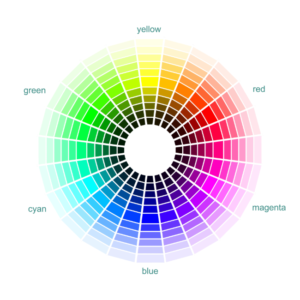Empower yourself with the knowledge of color psychology. This understanding can guide your decisions in design, marketing, and other fields, enabling you to effectively communicate with your audience and evoke the desired emotional responses.

The Fascination of Color Psychology
Color psychology is a fascinating field that explores how different colors affect human mood and behavior. Let’s dive into some key aspects:
Meanings of Colors
Colors have inherent meanings and connotations. For example:
- Red: Often associated with energy, passion, and excitement.
- Blue: Linked to calmness, trust, and stability.
- Green: Symbolizes nature, growth, and harmony.
- Yellow: Represents optimism, happiness, and creativity.
- Purple: Conveys luxury, creativity, and spirituality.
- Black: Signifies sophistication, elegance, and mystery.
- White: Associated with purity, simplicity, and cleanliness.
Emotional Reactions
Different colors evoke specific emotions. For instance:
- Warm Colors (Red, Orange, Yellow): Tend to be energizing and attention-grabbing.
- Cool Colors (Blue, Green, Purple): Create a sense of calm and relaxation.
- Neutral Colors (Gray, Beige, White): Often associated with balance and neutrality.
Cultural Differences:
Color meanings can vary across cultures. For example:
- Red: In Western cultures, it symbolizes love and passion. In some Asian cultures, it represents luck and celebration.
- White: In Western cultures, white signifies purity, while in some Eastern cultures, it symbolizes reflection and remembrance.
Practical Applications
Businesses and designers leverage color psychology:
- Branding: Companies choose colors that align with their brand identity and evoke desired emotions.
- User Interfaces: Apply calming or invigorating colors to different sections of a digital interface to create a welcoming and engaging user experience.
- Interior Design: Room colors impact mood (e.g., calming blue for bedrooms).
- Marketing: Product packaging, logos, and advertisements use colors strategically.
- Healthcare: Hospitals use soothing colors to promote healing.
Well-Being and Safety
Colors can influence mental well-being and safety:
- Nature: Spending time in green environments reduces stress.
- Visibility: High-contrast colors enhance safety (e.g., road signs).
Empowering Yourself with Color Psychology
Understanding color psychology is essential for anyone involved in design, marketing, or any field where visual communication plays a key role. By exploring color psychology, you can gain insights into how different colors impact human emotions and behaviors. For instance, knowing that blue conveys calmness and trust, while red evokes energy and passion, can guide your decisions in creating impactful designs. This knowledge helps you choose colors that resonate with your audience, create meaningful experiences, and effectively convey your intended message. By mastering the principles of color psychology, you can enhance the emotional appeal and effectiveness of your projects.
Remember, your color choices matter. Whether you’re designing a website or choosing an outfit, each color sends a message. By understanding color psychology, you can make informed decisions that resonate with your audience and create meaningful experiences.



